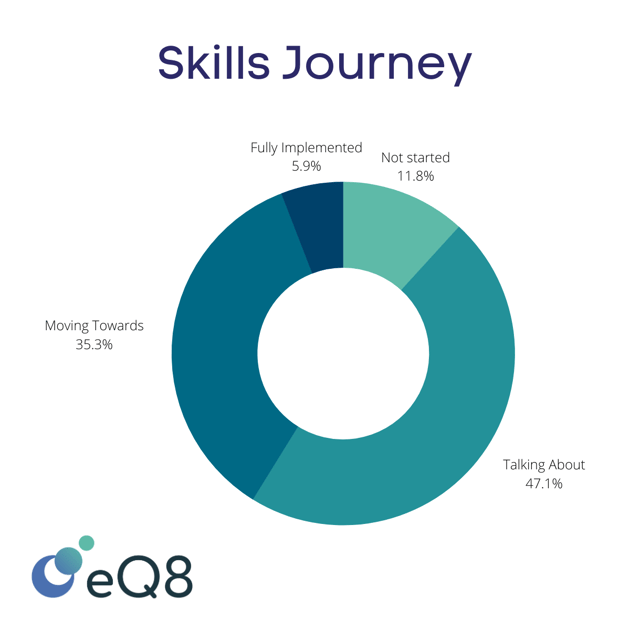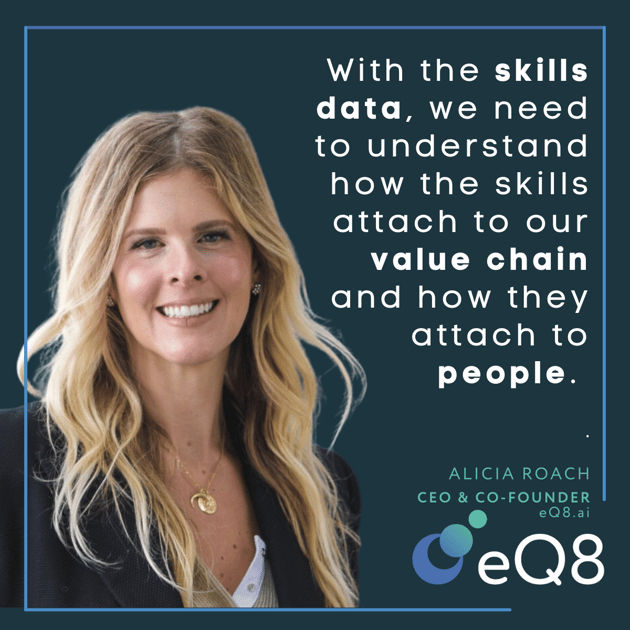Skills, Skills, Skills

Welcome to the second installment in our recap of the recent webinar Navigating Uncertainty, Emerging Effectively. Today's topic is one that has certainly been top of mind for many of us: Skills.

Interestingly, and probably not surprisingly, the majority of people were either talking about it but haven't done anything just yet, or are starting to move to towards it. Very, very few people have fully implemented, but also very few people actually not started yet, which is encouraging. But I think this is probably representative of of where a lot of organizations are at the moment. You know it has been something that we've been talking about for a while in the industry.
It is quite a daunting and tough thing to get started with as well, and so not surprising that a lot of people are in that process of getting started. So if if we think about that journey that people are on Chris and and Alicia a term that I heard recently which I really liked. There was a podcast where the CHRO at Standard Chartered Bank was on, and she was talking about sunrise and and sunset jobs, and how at Standard Chartered, they're thinking about roles in this way when they think about this need for upskilling and reskilling that's going on in their industry. And they're seeing certain jobs going away. So those would be the sunset jobs. They're seeing new jobs coming in. Those would be the sunrise jobs.
We always see a lot of organizations spending a lot of time and effort and money in trying to create the perfect skills ontology, and they've got two-year programs to do that. And certainly, we need to get some of that fundamental stuff right, but also we can't wait two years to answer these questions and understand what our critical skills are, and what critical roles, and what's going to be a show stopper for our business .In the face of all this change, we can't lose sight of that and wait two years to get the perfect ontology, the perfect data and the perfect processes.
With the external data. You know the labor market insights. That is great and interesting, but it's very outside in. You know what we always say in in analytics is, "So what what does it actually mean for us? And now, what what are we going to do about it?" And the outside in view will not do that for you, because it's not going to actually get to the business problems that you need to solve for the the questions that your organization needs to answer. And I think that's the missing piece, and that's what strategic workforce planning (SWP) really does. It makes that connection, as I said earlier, of the workforce and the skills to the activities the organization needs to to be doing, and gives that real clarity for an organization on where they need to focus. And the other thing that I I often say, and I, I laugh about skills because, you know you can get on Linkedin, or you can get an email, and it's always got: these are the top 10 skills by 2025. Everyone needs resilience and active listening, or whatever, but the skills themselves aren't free floating units. What do you do with that piece of information? You don't just go to your talent acquisition team and go hire me 600 resilience and I need 359 active listening and 25 leadership.
They're not free floating units that we can just go out and procure. They're attached to a human.

Fundamentally, we need to make sure that we're able to deal with skills-based talent management across the employee lifecycle.
We can't just go, "Here's this interesting bit off information, but we're not equipped to do anything with it." So there's a whole piece that needs to come with that. And for us, we obviously believe SW.P paves the way to navigate that and create that connection of the skills insights to actionable intelligence.
It's probably fairly clear to people, although I I think, for some kind of at the start of talking about getting into skills, they're not actually really sure what the differences between a talent marketplace and a talent inference, and what strategic workforce planning does. But I think there's a sequence here.
And there's another element to this, too, around how skills are important, and you talked about them not being detached things, but how skills fit against roles, and therefore bring both those things together.
Alicia Roach: Yeah, absolutely. If if you fundamentally don't understand what your organization needs from a skill perspective, the rest of it's kind of, "so what". What I mean by that is that we really need to be demand-led. And so we need to understand:
"What's our organization trying to achieve? What's our purpose? What's our strategy, and what skills are required to enable that?"
Alicia Roach
eQ8
That gives us the context for why we need to care about what skills we have internally and why we need to care about what's going on externally with skills supply and demand in the market.
If we don't have that demand-led view, the rest of it becomes irrelevant. We can go, "Everyone's hiring for these skills that competitors are hiring for." But actually, when we look internally, that's not part of what we're trying to achieve with our strategy. We're not heading in that direction.
Or maybe we are. Maybe that kind of feeds back into our direction. But again we need to bring that back through our strategic lens, and then that becomes the demand-led basis.
If we just look at this talent marketplace, and we've got an understanding of what skills we've got in our workforce today, and what skills we need in our current state of open requisitions, that's interesting. But again we're in that short-term kind of view, and we know that you can't click your fingers and materialize these skills overnight. They've got lead times. They take time.
So we need to have that longer term demand-led view of what skills we need, what's critical for us, so that we give ourselves time as an organization to get those skills in place. Then we can see that our talent marketplace is showing that we've got the skills we we know that we need next year. What have we got today? We can see that from our talent marketplace, but we can see that there's a gap here.
What skill do we need? To what level of proficiency, and when? We need all of those parts to be answered. And the external data is a lagging indicator of what's being hired up to today. So it gives us a good sense of how things are shaping and trending, but it's a lagging indicator, and you can extrapolate that and forecast it, but again, we're missing the context of the organization and what it needs for the future. We can only do that with strategic workforce planning.
Ian Bailie: So it's skills, but it's skills embedded against roles?
Chris Hare: Yeah, we need to be able to see that and have that clarity, and that really helps us to set that forecast and get that context and to decide what we're going to do about it.
Ian Bailie: And and I think what's interesting in my experience of where people get kind of stuck in in this, it's often that isn't it? It is quite daunting to try and think about as you just described it. You should, on both the supply side and the demand side, think about your entire workforce. All of your roles. To do all of it at once is practically impossible.
There's a few things that I've seen people do that have been been helpful. You know one is, do you really need to know the skills of absolutely every role and every function and every person straight away? Probably not. Does it really matter how good your Finance Department skills are right now? Well, maybe it doesn't. If that's not a critical thing for you from a strategy perspective. So what are those critical roles? What is that hot area for your strategy that you're really focusing on?
Is there a certain business unit or some certain key roles that you should focus on? And then within that, are there certain key skills as well, and so really narrowing that in maybe finding an area to start with from a pilot perspective, I think, can be really helpful. And then I think the fact that you mentioned external data as well. Yes, it is lagging, but it can be incredibly helpful to get people started. If you know what you have, you don't have to ask people what skills they have. Skills they should have, because they're in that role, and that can get you started a bit as well. And so I think that's part of the puzzle here as well.
Alicia Roach: Inference can be useful, and we certainly do that in our platform when our customers import their work for supply, it infers what skills are attached to that, and that's useful. I guess what I meant more by external data is the labor market's doing this and hiring this and that can be useful for me when you are getting to the action planning stage and you're going. Okay, how are we trying to close the gaps? How can we source this? What decisions do we make around Build, Buy, Borrow? And how do we make those more effectively? But in and of itself as a starting point, just going the market's hiring this and that until you again contextualize it back. That's kind of where I was more coming from.
